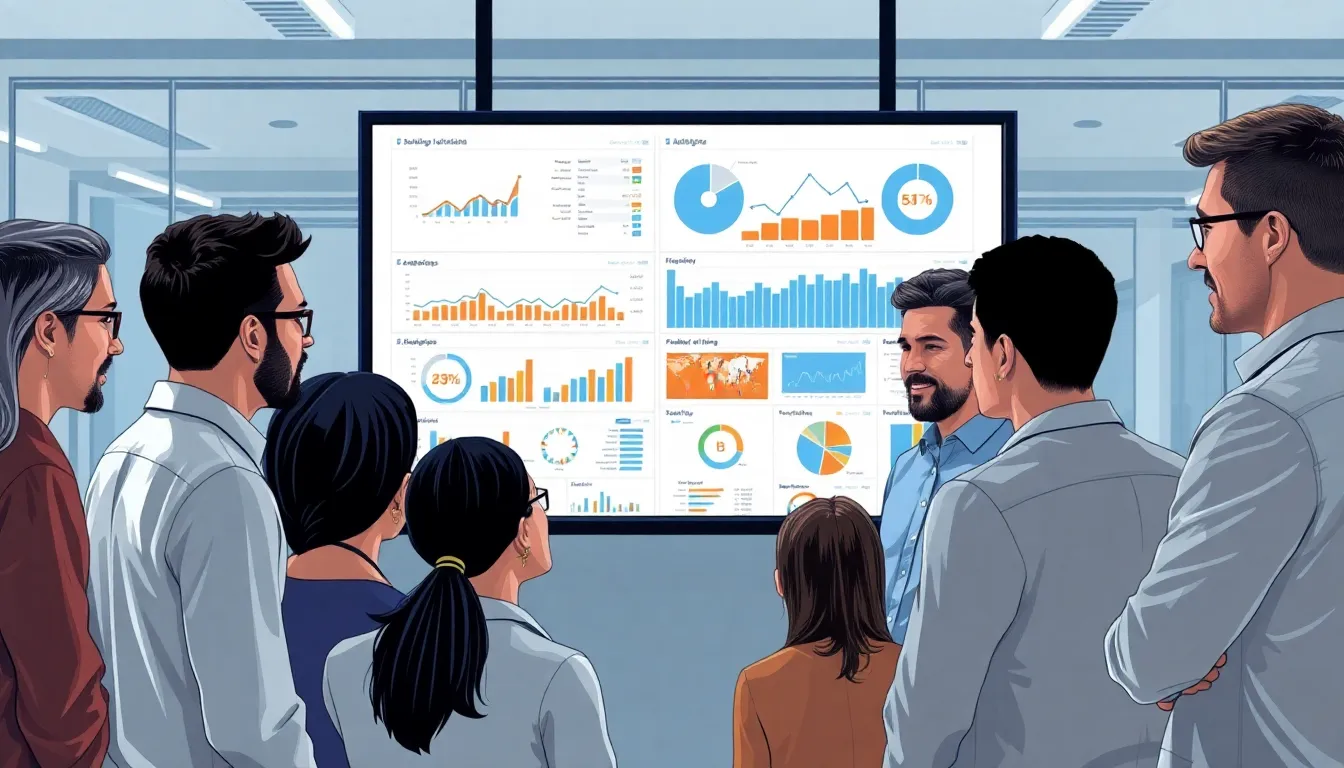Table of Contents
ToggleIn a world where data reigns supreme, advancements in data analytics are transforming how businesses operate. It’s like giving a magnifying glass to Sherlock Holmes—suddenly, every clue becomes crystal clear. From predicting customer behavior to optimizing supply chains, the power of data analytics is making companies smarter, faster, and sometimes even a little sassier.
Overview of Data Analytics Advancements
Data analytics advancements enable organizations to harness vast amounts of information effectively. Enhanced algorithms and machine learning techniques drive these developments, allowing for deeper insights into consumer trends. Visualization tools significantly improve data interpretation, making complex datasets easier to analyze. Businesses can now track customer behaviors in real time, facilitating proactive strategies and responses.
Artificial intelligence integration amplifies the capabilities of data analytics platforms, automating repetitive tasks and revealing patterns. Organizations use predictive analytics to forecast market trends, enabling them to stay ahead of competition. Data governance practices have also evolved, ensuring that data quality and security remain a priority.
Cloud-based analytics solutions allow companies to access and analyze data from anywhere, increasing collaboration opportunities. Advanced analytics frameworks support more sophisticated decision-making processes, which enhances operational efficiency. Real-time analytics provide immediate feedback on performance metrics, allowing businesses to optimize their operations effectively.
Companies benefit from cross-functional analytics that merge data from marketing, sales, and supply chain departments. Insights drawn from these assessments lead to more streamlined processes and improved customer relations. Data analytics advancements are undeniably transforming how businesses operate in today’s competitive landscape.
Key Technologies Driving Innovation

Data analytics innovations arise from various cutting-edge technologies. These advancements empower organizations to extract valuable insights from complex datasets.
Machine Learning Integration
Machine learning enhances data analytics by enabling systems to learn from data patterns. Algorithms process vast amounts of information, uncovering trends and relationships that humans might overlook. Organizations employ supervised and unsupervised learning techniques to improve predictions and decision-making processes. Specific applications include customer segmentation, fraud detection, and predictive maintenance. Solutions offered by machine learning evolve continuously, adapting to new data inputs for accuracy. Therefore, businesses experience improved efficiency and enhanced strategic planning.
Big Data Technologies
Big data technologies support the collection, storage, and analysis of immense datasets effectively. Solutions like Hadoop and Apache Spark facilitate the processing of large volumes of structured and unstructured data. Companies utilize these technologies to gain agile insights into performance metrics and market conditions. Real-time data processing capabilities significantly enhance operational responsiveness. Tools such as NoSQL databases provide flexible schemas, allowing organizations to manage diverse data types seamlessly. As a result, organizations optimize their operations and ensure their strategies align with current trends.
Impact on Various Industries
Advancements in data analytics significantly influence various industries, driving efficiency and innovation.
Healthcare Sector
Data analytics revolutionizes healthcare by improving patient outcomes. Hospitals utilize predictive analytics to forecast patient admissions, enhancing resource allocation. Real-time data monitoring allows healthcare providers to track patient health, leading to timely interventions. Furthermore, analytics streamline patient records, providing quick access to vital information. Organizations analyze treatment effectiveness and patient feedback to optimize care plans. Robust data governance ensures compliance with regulations, maintaining data integrity and security. Continuous advancements enable healthcare professionals to harness vast amounts of clinical data for better decision-making.
Financial Services
The financial services sector thrives on data analytics, transforming risk management and customer insights. Institutions adopt machine learning algorithms to detect fraudulent transactions in real time, safeguarding assets. Predictive analytics helps in assessing credit risk and loan approvals, enhancing decision-making accuracy. Moreover, businesses leverage data visualization tools to interpret market trends and consumer behaviors effectively. Tailored financial products arise from analyzing customer data, fostering deeper engagement. Data-driven strategies support compliance with regulations, fortifying operational resilience. The integration of cloud-based solutions enables swift data access, facilitating informed financial planning.
Retail and E-Commerce
Retail and e-commerce operations benefit immensely from data analytics, optimizing inventory management and enhancing customer experiences. Retailers analyze purchasing patterns to forecast demand, reducing stockouts and overstock scenarios. Personalization strategies emerge from understanding customer preferences, driving loyalty and sales. Advanced analytics tools track customer interactions across platforms, providing insights into shopping habits. Moreover, businesses employ A/B testing to refine marketing strategies, improving conversion rates. Collaboration between departments, fueled by cross-functional analytics, leads to a seamless customer journey. Continuous innovation empowers retailers to adapt to shifting market dynamics, ensuring competitiveness.
Challenges and Considerations
Organizations face several challenges when implementing advancements in data analytics. Addressing these challenges is vital for maximizing the benefits of data-driven decision-making.
Data Privacy Concerns
Data privacy remains a significant issue as businesses collect vast amounts of personal information. Ensuring compliance with regulations like GDPR and CCPA is crucial for organizations. They must also implement robust data protection measures to safeguard customer information. Organizations can face legal repercussions and reputational damage if breaches occur. Strong encryption methods and regular audits help mitigate risks and foster trust among consumers.
Skills Gap in the Workforce
The skills gap presents another challenge for organizations embracing data analytics. Current employees may lack the necessary expertise to leverage advanced analytics tools effectively. Training programs and partnerships with educational institutions can bridge this gap. Organizations benefit from investing in employee development by creating a skilled workforce proficient in analytics. It’s essential to continually assess and strengthen workforce capabilities to stay competitive in the evolving data landscape.
Future Trends in Data Analytics
Emerging trends in data analytics focus on enhancing predictive capabilities. Organizations invest in advanced machine learning algorithms to improve accuracy and efficiency. Additionally, artificial intelligence integration automates data processing, streamlining workflows and reducing human error. Cloud computing plays a pivotal role in this evolution, enabling more flexible and scalable data solutions.
Real-time data analytics drives immediate decision-making. Businesses leverage real-time insights to adapt strategies quickly, enhancing their competitive advantage. Cross-functional data integration fosters collaboration across departments, ensuring unified access to insights. Enhanced visualization tools help stakeholders interpret complex datasets effectively, enabling better understanding and quicker responses.
Data privacy and security remain significant concerns. As regulations like GDPR and CCPA shape practices, organizations prioritize compliance while maintaining data integrity. Cybersecurity measures must evolve alongside analytics advancements to protect sensitive information. Training and education initiatives help develop a workforce equipped with the necessary skills to navigate these challenges.
Sustainability trends influence data analytics in various sectors. Industries are adopting analytics to optimize resource consumption, monitor environmental impact, and enhance reporting. Healthcare applications utilize predictive analytics to improve patient outcomes and resource allocation, while financial services rely on analytics for risk management and regulatory compliance. Retail and e-commerce harness data to personalize customer experiences, fostering loyalty and driving sales growth.
Collaborative platforms gain traction, allowing teams to share insights seamlessly. Enhanced data storytelling transforms complex information into engaging narratives, making analytics accessible to non-experts. By embracing these trends, organizations can turn data into a strategic asset, positioning themselves for growth in an increasingly data-driven world.
Advancements in data analytics are reshaping the business landscape by enabling organizations to leverage information more effectively. The integration of machine learning and artificial intelligence empowers companies to derive actionable insights and streamline operations. As industries continue to evolve, real-time analytics and cross-functional collaboration will play pivotal roles in driving innovation and efficiency.
However, businesses must navigate challenges such as data privacy and workforce skill gaps to fully capitalize on these advancements. By investing in training and adopting robust data governance practices, organizations can ensure they remain competitive. Embracing the future of data analytics will not only enhance decision-making but also position companies for sustainable growth in an increasingly data-driven world.




